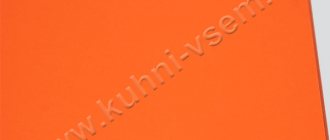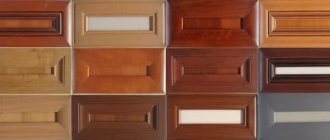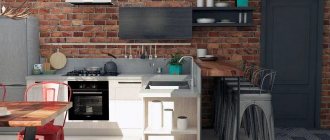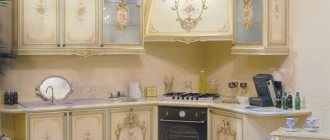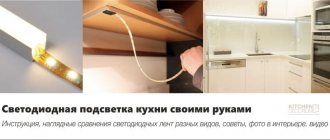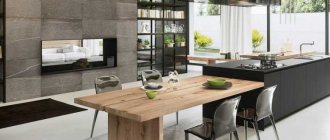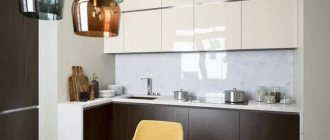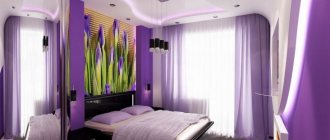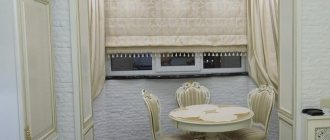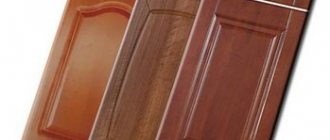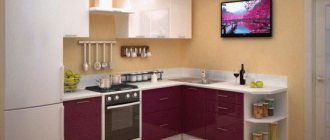Pros and cons of MDF for the kitchen
Medium density fiberboards are very popular for the production of interior items. The product has good performance characteristics that set it apart from the rest. But in the manufacture of kitchen sets, MDF is used as a basis for subsequent cladding with protective and decorative materials. The parts are used to create fronts, moldings, splashbacks and trim panels that cover visible areas of cabinets.
Medium and high density MDF panels are used to create furniture facades
Painted
To obtain such products, special enamel is applied to the prepared panel in several stages, after which the surface is treated with varnish and each layer is sanded alternately. This method allows you to obtain a matte, glossy or chameleon effect finish.
Main advantages of the material:
- Environmental friendliness. The products are safe for health.
- Durability. The surface is not damaged due to exposure to steam or grease, but requires proper care: it cannot be washed with aggressive chemicals or abrasives.
- Attractive appearance. The parts are available in a wide range of colors and different effects.
The latest hit when painting kitchen facades from MDF is the use of automotive paints and varnishes
- Low wear resistance to mechanical stress. The surface can be easily damaged, but if there is a layer of varnish, small scratches can be removed by sanding. Chips in paint are extremely difficult to restore.
- Expensive. The technology for obtaining the coating is quite complex and requires compliance with many conditions, which explains the high price.
- Fingerprint effect. This is a problem with many bases: marks remain on them even with minor contact.
While fingerprints on furniture enamel can still be wiped off, scratched gloss is very difficult to restore with your own hands.
Important! When using such products, it is necessary to take a responsible approach to choosing a manufacturer, especially when making to order.
Veneered
Veneering MDF boards allows you to obtain a surface that is closest to natural. To create such a coating, a thin cut of valuable trees is used, which is obtained using various methods. Gluing veneer requires adherence to a certain technology, and therefore must be carried out using special equipment.
The technology for gluing MDF with veneer is relatively simple, but high-quality installation is only possible with professional equipment
- Availability. The cost of production is much lower than the array, taking into account the excellent result.
- Environmental friendliness. The parts comply with all existing standards.
- Strength. Unlike natural wood, the resulting products are not subject to temperature deformation and are resistant to moisture.
A significant drawback of the material is the presence on the market of manufacturers who do not comply with manufacturing technology. This coating is extremely susceptible to prolonged exposure to hot steam and can peel off even with minimal load.
Covered with PVC film
One of the most popular and affordable varieties. To obtain it, a thin layer of polyvinyl chloride with the desired decorative effect is laid on an MDF base using vacuum pressing.
- Highly decorative. The film finishing of MDF facades is distinguished by a rich range of colors and imitation of wood texture with a variety of reliefs.
Decorative PVC film allows you to create beautiful kitchen facades based on MDF at an affordable price and with decent quality
- Wear resistance. The film can withstand heavy loads, but if damaged, it cannot be restored.
- Safety. The production technology allows us to obtain a reliable surface that is not harmful to health.
- Burnout. Under the influence of ultraviolet radiation, the coating loses its visual appeal.
- Possibility of peeling. If the furniture is located near heating devices or is constantly exposed to steam, the film on the facade becomes deformed, this is especially noticeable at the edges.
- The need for proper care. The coating must not be washed with caustic chemicals or cleaned with abrasives.
Although the material has many advantages, it also has serious disadvantages:
PVC film is considered the simplest option for restoring old furniture, but here it is important to take high-quality film and strictly follow the technology, otherwise the result is not guaranteed
Parts with a PVC surface are the most affordable among other options due to advanced production technology.
Advantages of film MDF
- Aesthetic design. The film can be matte, semi-matte, glossy, and is available in different colors. High-quality matte facades look almost the same as paint. The material can be easily embossed, so you can order a textured film that imitates wood, which will look like a real solid. In addition, elements are made with imitation of marble or other types of stone, leather, and textiles.
- Strength. PVC coating not only gives the material the desired appearance, but also protects it from mechanical stress or other damage. The film is highly durable; when heated, it becomes plastic, so it adheres tightly to the base. The finished coating lasts a long time without peeling. The base is also durable and resistant to high humidity.
- Possibility of milling. Film MDF can be milled to create classic facades with an attractive design or furniture in a modern style.
Longford kitchens made from film MDF. More photos in the catalogue.
- Possibility to produce furniture with curved surfaces. The production technology makes it possible to obtain curved elements.
- Affordable price. The material is cheaper than painted MDF and solid wood. Such facades will be even more affordable if you order them from Master Furniture showrooms in February - they have a 45% discount for the entire month.
- Fast production. Manufacturing kitchens with MDF film facades takes up to 48 working days (for other options – up to 68 days).
- 5-year warranty, which confirms the reliability and high quality of products.
Plastic
A modern type of processing may include several varieties depending on the type of coating obtained. However, the question “which material is better to choose for the kitchen: MDF or plastic” is not entirely correct, since medium-density fiberboards, along with chipboards, can be the base that is covered with this material.
Types of coating
- CPL. This is the so-called medium pressure plastic. It has stable properties, but fades when exposed to sunlight for a long time. The main advantage is the cost: it is lower than other varieties.
- HPL. High pressure plastic. To obtain it, special pressed paper impregnated with polymer resins is used. Thanks to the technology, the products acquire sufficient rigidity, therefore they are produced in sheets.
- Acrylic. This plastic coating is obtained through a rather complex process. The MDF base is pre-treated: a hardener and primer are applied. After this, the surface must be painted or patterned and covered with transparent acrylic. Additionally, ultraviolet irradiation is performed.
The most practical are HPL plastic and acrylic coating, but with similar aesthetic data, acrylic is more expensive
Advantages and disadvantages
All plastic materials have similar characteristics.
Main advantages of the product:
- Decorative. Processing allows you to obtain a deep glossy effect and rich color.
- Easy to care for. Due to their antistatic properties, the products do not attract dust.
- Durability. Acrylic and HPL plastics have high wear resistance, including resistance to steam and water.
Plastic kitchen trim, where the top is glossy and the bottom row is matte, is considered the optimal combination of beauty and practicality
But there are also disadvantages:
- Impossibility of complex processing of kitchen facades. It is possible to apply plastic to curved parts, but this does not always provide the required strength and significantly increases the cost.
- Fingerprint effect. Minimal contact marks remain on the surface, especially with deep gloss.
- The need for proper care. The coating must not be washed using abrasive substances.
The popularity of such processing is increasing more and more and is limited only by the final cost.
Production of MDF with paint and MDF with film
The film is applied to MDF facades using a press, creating high temperature and vacuum. Paint is applied under normal conditions: at “room” temperature, with existing atmospheric pressure. First, the surface of the MDF facade is coated with a primer. Next, a special enamel is applied. If necessary, additional layers of enamel are applied and the façade is varnished.
The properties of furniture facades also depend on coating technologies.
What to choose?
To answer this question, you need to compare the materials:
- Price. The most expensive are enameled parts, followed by veneer, plastic and products with PVC film.
- Durability. Acrylic and enamel coatings lead in this category. Veneered ones require a certain humidity, and elements made of polyvinyl chloride should not be exposed to temperature.
- Wear resistance. According to this parameter, plastic and painted MDF stand out. The veneer is also quite durable because it has a protective treatment. PVC film is not so durable, but it is not easy to damage.
- Decorative. Although all products have visual appeal that allows you to create a beautiful individual interior, the painted facades especially stand out. Enamel can be laid on flat or textured surfaces, creating various effects.
When deciding what to choose, preference should be given to acrylic and HPL coatings. But the polyvinyl chloride surface should not be written off either, since in most cases the problem of peeling is associated solely with non-compliance with production conditions.
Source: otdelkagid.ru
Advantages of laminated chipboard
Chipboard - chipboard, replaced facades made of ordinary wood. This material has become a budget option for making kitchen furniture.
The basis of the material is dried shavings, pressed together with synthetic resins. For a better appearance, the chipboard is varnished, and the surface is covered with additional material that hides the unevenness remaining after sanding.
Laminated chipboard is the cheapest option for making a facade. But, unfortunately, of poor quality. A kitchen facade made of this material will look cheap and unattractive. Laminated chipboard cannot be adjusted to the desired shape, since it is not flexible. Only simple designs can be made from it, which can hardly be called fashionable and easy to use.
- very cheap material;
- can be used as a temporary option.
- low quality;
- must be covered with additional material;
- simple and unattractive appearance;
- low heat and moisture resistance;
- requires constant care.
The main positive quality of laminated chipboard is its low cost. This material may not be the best option for making fashionable kitchen furniture. Moreover, it does not meet all standards of kitchen equipment. But LDPS will be an ideal temporary option for a kitchen facade or a new addition to a rented apartment.
Conclusion
Among the methods of covering MDF, finishing with film received a well-deserved victory in terms of the breadth of use by the consumer. In addition to several minor disadvantages, a kitchen with a film coating has great advantages, you can see this by watching the video:
It is easy to structure and can be left smooth and even. It is possible to implement multiple color shades. Easy to clean, resistant to impacts and scratches. MDF kitchens can match any style and taste.
One could argue about the durability of kitchen furniture. This means that the film will fade, and may even peel off at some point. But only now is it customary to replace furniture with new ones, not because the old one has fallen apart. It just may not correspond to the current time and style.
Gallery
Did you like the article? Subscribe to our Yandex.Zen channel
Great article 0
Advantages of plastic
Unlike MDF and laminated chipboard, plastic is not the basis for the manufacture of kitchen furniture, but its decorative coating. This is the best way to preserve the appearance of the facade. Thanks to this additional coating, kitchen furniture will last much longer and retain its appearance. Caring for a plastic surface does not present any difficulties: it can be easily cleaned with detergents without absorbing them, and is easily wiped off from dirt.
Since plastic is only a coating, a base is used to make the kitchen facade. Such a basis can be a budget option - chipboard or a more expensive one - MDF. During processing of the base material, plastic is glued to its surface.
The plastic is based on ordinary paper, which allows you to combine different colors, designs, and create a unique product for further use. Color design will favorably emphasize the appearance of kitchen furniture and make it more visually attractive.
- durable to use;
- heat resistant;
- moisture-resistant material;
- large selection of colors and patterns;
- easy to clean, does not absorb heavy dirt;
- does not fade in the sun.
Thus, plastic will become the best material for additional coating. It is perfect for a long period of use and will be well preserved. Cleaning kitchen surfaces will become even easier, since the plastic is easy to wipe off and does not come into contact with detergents.
What material is better to use?
The answer to this question depends on several factors.
Firstly, the price characteristic. If kitchen furniture should become a regular budget option, you should use laminated chipboard. MDF is a much better option, but accordingly it costs more. It resembles natural wood and is of higher quality.
Secondly, surface treatment. Chipboard is initially treated with varnish, but the coating must be finished with plastic. With the help of finishing material, the top ball of the kitchen facade will become smooth and suitable for use. The surface of MDF can be treated with enamel or PVC film. This will improve the appearance of the facade and make it smoother. In order to extend the life of the facade, it is better to treat it with additional material – plastic.
Thirdly, the shelf life. If kitchen furniture is made for a long period, you should spare no expense and choose MDF. Laminated chipboard is perfect only as a temporary option.
Fourthly, design. If you plan to make kitchen furniture in a fashionable style with round corners and additional design options, MDF will be the only option.
Finding the right material for making kitchen furniture is very difficult. It all depends on the price characteristics, duration of operation, appearance and design. The market offers a wide selection of raw materials for kitchen facades, but the best option is plastic-coated MDF. It includes all the necessary qualities to produce perfect kitchen furniture.
How to treat the ends of acrylic facades
The material itself is quite expensive compared to others. And it requires an equally expensive “frame.”
Typically, a glossy PVC edge in color or a 3D edging is used as an edge.
Can't match the color? Metallic is universal. As an option, the perimeter can be rolled up to match the color of the kitchen body.
The aluminum end is another way to emphasize the modern style of the kitchen. You can read more about methods for rolling ends here.
Kitchens based on MDF
Furniture stores offer a wide range of kitchen sets. You can find MDF cabinets that are lined with a variety of materials. Natural wood veneers are used, but such kitchens are expensive.
The following types of facades based on MDF are popular:
Reference ! Some types of MDF cladding are not inferior in quality to wood, but are much cheaper.
Made from painted MDF
The most popular material for facades is painted MDF. It is available in stores in a variety of colors and designs. In production, parts are cut out in accordance with the type of model, thoroughly cleaned, primed, and coated with several layers of special varnish. Such kitchens have an affordable price.
Advantages of painted facades:
- large assortment and variety of shapes;
- several coating options (matte, gloss, mother-of-pearl or chameleon);
- practicality, ease of care, resistance to absorption of moisture and odors.
The coating also has disadvantages. They all relate to his appearance. With infrequent care and constant exposure to sunlight, the product becomes dull, and fingerprints are very noticeable on the surface. If struck or touched with a hard object, cracks or scratches may occur.
One alternative option is enamel. It is created on the basis of varnish, but has advantages: enamel facades are more practical and are not so easily damaged. However, they can also suffer from exposure to ultraviolet radiation. The price of such furniture is higher, but the appearance is better than other options.
MDF facades with PVC film
Decorating a kitchen from MDF using PVC film is considered the most budget option. Low cost is due to ease of production and low cost to the manufacturer. Facades are created by gluing film over treated MDF. Headsets with this coating are especially popular.
How to care for high gloss MDF?
As practice shows, facades made from ready-made High Gloss panels perform better in operation than those lined with acryline. They are harder to scratch (although you can if you wish) and easier to polish. All maintenance comes down to the systematic removal of fingerprints, splashes of water and other typical kitchen contaminants. On gloss, in certain lighting, everything is visible. Especially dark.
You need to be prepared for this. A kitchen with acrylic, high-gloss MDF facades is more of a designer furniture. Durable and unpretentious in terms of wear resistance, the acrylic surface is not afraid of moisture, temperature changes and is resistant to ultraviolet radiation. But quite demanding to care for. To keep the mirror gloss in an aesthetically acceptable condition, you need to acquire special antistatic and polishing agents. An antistatic agent will help create a layer that repels dirt and dust on the surface, and a polish will help mask the smallest scratches. But acrylic facades are easy to wash – a simple soap solution is enough. It is better not to use alcohol, chlorine-containing and abrasive compounds. Yes, they are not needed for care.
By the way, acrylic panels are used not only as facades for the kitchen, but also for making bathroom furniture. The reason is good resistance to moisture with high-quality end processing and aesthetics.
Plastic facades
A popular solution for finishing kitchen facades is plastic. It is used only for external decoration.
The question of what is better for the kitchen: MDF or plastic does not make sense. The fact is that they are used simultaneously: MDF as a base, and plastic as a finish. Sometimes chipboard or a special frame is used as a basis. In the latter case, you can already argue about which material is better. Plastic has a lot of advantages even if it is used as a finish.
Plastic facades are durable and wear-resistant. But the decisive factor in choosing a kitchen made of plastic or film is the former’s immunity to sunlight. Advantages of plastic facades:
- resistance to temperature changes and moisture;
- strength, due to which small scratches do not appear on the surface;
- the plastic will not peel off from the base under mechanical stress;
- glossy surface, visually increasing the space and improving the interior;
- the ability to imitate various materials;
- environmental friendliness, practicality, ease of care.
When choosing enamel or plastic for the kitchen, it is worth considering that fingerprints are clearly visible on glossy surfaces. The downside is that over time, scratches appear on the plastic, which cannot be masked by anything.
Sometimes manufacturers use acrylic panels. They are also classified as plastic, since their surface is covered with a thin layer of transparent plastic. This increases the life of the kitchen to 40 years, and plastic can last about 25 years.
Important ! Often cheap plastic is deformed during installation or during operation from exposure to water, or due to temperature changes.
Frame facades made of MDF
In the question of which kitchen is better: plastic or MDF, you should also consider the option with frame facades. They can transform the interior, making it more attractive in appearance and price. The main feature of this solution is its appearance, in texture and style as close as possible to wood. It matches perfectly with mirrors and glass inserts.
What can attract frame facades made of MDF:
- the ability to combine different materials;
- the use of several decorative elements inside the frame at once;
- light weight, easy delivery;
- a rich assortment with different shapes and colors.
There are few disadvantages of this product, but they are significant, so you should pay special attention to them. Frame facades may have the following disadvantages:
- deformation when exposed to moisture;
- delamination of the material when left in a warm and dry room for a long time;
- difficulty of maintenance, risk of damaging the surface when using chemicals.
The use of frame facades in the manufacture of kitchen units is a good solution. This reduces the cost of furniture without affecting its quality.
Which is better, enamel film or plastic?
What is better enamel, film or plastic?
Today, furniture made from MDF has become widespread and is in great demand due to its excellent appearance, affordable price and excellent operating properties. Every housewife dreams of a kitchen that will bring comfort and joy to the house and create a great mood for preparing various culinary masterpieces. What to choose from all the variety presented today, because you want to have a kitchen that is beautiful, comfortable and practical. To make a decision, you need to familiarize yourself with the pros and cons of various MDF coatings. MDF coatings come in enamel, plastic and film. Below is a detailed comparison of MDF coatings.
MDF-Enamel(Paint)
PROS:
One of the main advantages is the opportunity to create a kitchen in a modern style. Using a huge palette of enamel colors, you can make your kitchen fresh and bright. The kitchen can be painted in any color, you can combine different colors, use a glossy or matte finish, and also create a kitchen with a metallic or chameleon effect. Enamel gives you great opportunities to experiment and create what you wanted. The technology of applying enamel is a complex procedure similar to painting a car. Initially, the facades are coated with a primer, then the MDF board is gradually covered with automotive paint in several layers, then varnish is applied and the surface is polished to a glossy shine. One of the advantages is also the ability to produce facades of various shapes: rounded, concave, convex, wavy, which allows you to create an individual style and bring to life any design solution.
The environmental friendliness and safety of the enamel used for painting is confirmed by numerous certificates; in addition, the enamel is unpretentious, both in use and in maintenance. Enamel facades are superior to natural wood in terms of density and performance, so you don’t have to worry about them losing their shape or color. Neither moisture nor odors are a threat to enamel facades, since high-quality varnish coating provides reliable protection against moisture and elevated temperatures.
MINUSES:
In accordance with the manufacturer's recommendations, when caring for enamel, you should avoid abrasives and acids (for example, Pemolux). One of the facts that is not in favor of enamel is fingerprints that can remain when touching the surface. Another disadvantage may be that the enamel is susceptible to mechanical damage and shock. The beautiful glossy surface may be damaged due to pots accidentally falling on it or other inaccurate mechanical impact. Due to the complex technological process and the high cost of the material used for painting, the price of MDF enamel is quite high.
EVENTUALLY:
MDF enamel is distinguished by an aesthetic appearance, as well as a rich color palette (about 300 colors); the rather high price is compensated by the environmentally friendly material and great opportunities in creating the design of the kitchen of your dreams.
MDF-PVC
PROS
MDF covered with PVC film is the most affordable and cost-effective option for making a kitchen. This is facilitated by the simple and economical process of facade production. The film is applied to a plate covered with a layer of glue and sent under the press. This way, beautiful facades of different textures are obtained: matte plain, glossy plain with a wood texture, smooth or with a wood texture that is noticeable to the touch. Facades can also have different shapes, either smooth or with different types of milling. A large selection of colors and textures will help you create any interior and decorate any kitchen. Compared to enamel, MDF-PVC facades are not afraid of abrasives and you can easily use them when maintaining your kitchen. MDF-PVC facades are not subject to changes in texture and color over time, except in cases of prolonged exposure to direct sunlight.
MINUSES:
The disadvantage of a film facade is that MDF-PVC facades tend to peel off when exposed to hot air or steam. The film may come off on cabinets near the kettle, hob and oven.
EVENTUALLY:
MDF-PVC facades are a combination of good quality and affordable price. With careful use, an MDF-PVC kitchen can delight you for many years. Regarding appearance, MDF-PVC facades are sometimes difficult to distinguish from facades made of natural wood, but they are more unpretentious in operation.
MDF plastic
PROS:
Kitchens made of plastic are one of the best developments in the furniture industry. The cost of plastic facades is higher than the cost of MDF-PVC facades, which is due to the more expensive cost of the material itself. Plastic combines all the best performance qualities of film and enamel. The manufacture of facades occurs by applying plastic to an MDF board coated with glue. Plastic surpasses film and paint in terms of service life and is considered the most wear-resistant and reliable material. Plastic facades do not fade, do not burn out, are not sensitive to temperature changes, and are also the most unpretentious in maintenance, unlike other coatings. One of the advantages is also that the facades have an aesthetic appearance and will help create a beautiful design in any kitchen.
MINUSES:
Due to its excellent performance characteristics, plastic has virtually no disadvantages. Minor disadvantages include not such a wide choice of colors as with film and enamel. The glossy plastic surface may also leave fingerprints. The price is higher than for film, but this fact is compensated by the better performance properties of the material.
EVENTUALLY:
In terms of price-quality ratio, plastic facades are the most profitable purchase, since they can be called the most durable. They are in the middle price segment between film and paint. A small selection of colors and soilability is compensated by excellent performance and ease of maintenance.
Right choice
It is very important to choose a façade made of high-quality and durable material. The best choice is made before going to the store. This will help narrow down your search by focusing on specific models.
Any material has its advantages and disadvantages. Upon detailed comparison, it becomes clear that plastic is a suitable option in terms of quality. It is able to provide a beautiful kitchen interior and last for many years without requiring replacement or repair. Its shortcomings seem insignificant compared to the disadvantages of other materials.
If you want to save money, you can consider the option with a film coating. To give the kitchen a special interior, frame models or products with an enamel finish are suitable.
When choosing a plastic or other headset, you should pay attention to a number of points that are important to consider when purchasing. Among them:
- manufacturer (it is recommended to purchase products from well-known brands);
- composition (cannot contain harmful substances or additives);
- appearance (the set should fit well into the interior of the kitchen).
You can always find an option that will please even the most sophisticated buyer.
Which panels are best for the kitchen: tips for choosing
The fashion for decorating walls or backsplashes with ceramic tiles is slowly but surely becoming a thing of the past. Increasingly, we choose other materials - from economical MDF to glass panels that are unimaginable in their design.
What is the advantage of wall panels? Firstly, the ease of installation. If the tiles require smooth walls and several days to lay, then the panels can also be installed on rough walls. Secondly, it's a matter of cost. Ceramic tiles are not a cheap pleasure, but laminated or plastic products will save your budget. Let's look at the entire range of materials for decorating walls and decide which ones are best suited for the kitchen.
Top three – from MDF to plastic
If you are faced with the choice of covering for kitchen walls for the first time, the first question that will arise is what types of wall panels are there? All products can be roughly divided into several types: glass, plastic, chipboard and MDF, as well as natural materials. Each type has its own advantages and disadvantages. Let's look at the top three, which are most often chosen for decorating and protecting kitchen walls.
MDF panels
Let’s say right away that you should choose laminated MDF as wall panels. This can be a product where only the front side is covered or a model with two laminated surfaces. The last option is better, more reliable, but more expensive. Laminated MDF, unlike regular sheet metal, repels dirt and is easier to clean.
This material has several other advantages:
- high strength and scratch resistance;
- soundproofing properties;
- variety of colors and patterns.
Such panels can be quite easily installed in the kitchen yourself. Below you can see photos of laminated MDF wall panels.
As for the disadvantages , it is worth saying that the material can easily ignite and does not tolerate constant moisture. Although the sheet is coated on both sides with a protective coating, it can become deformed from exposure to moisture.
If you need to wash off grease from laminated MDF, it is better to use soft sponges and brushes.
Plastic products
The most popular option for covering kitchen walls. Its main advantages are versatility and affordable cost. If ten years ago plastic was used most often in government agencies, today this material has become more versatile due to the appearance of more colors and textures. What's good about plastic:
- Wall panels made of this material are easy to clean and are not afraid of chemicals.
- Plastic is moisture resistant. It, like tiles, can “survive” high humidity and constant ingress of water.
- Plastic has good sound-proofing and heat-insulating properties.
Another advantage worth noting is the ease of installation. When tiles require laying skills and wall preparation, plastic can be installed in a few hours. Modern kitchen panels made of plastic can be not only the standard snow-white color, but also have a glossy shine, textured patterns and eye-catching colors. In the photo below you can look at the interior of the kitchen, where the walls are lined with plastic panels.
“Expensive walls”: options for exquisite wall decoration
In addition to the popular panels made of MDF, chipboard and plastic, there are other types of materials that can be used in the kitchen. Of course, they will not be cheap, but they will be able to create the right atmosphere in the room or emphasize the features of the interior.
- Wooden panels. The most expensive material, the main advantage of which is its respectable appearance. In the photo below you will see what kind of kitchen interior can be created using such panels. Wood is difficult to clean without damaging the structure; it is afraid of constant humidity and can become deformed. True, today such models are coated with special wax, which extends their service life.
- Tempered glass panels. Such products are popular, and their characteristics are not inferior to the ceramic tiles we are used to. But glass panels have one advantage compared to tiles, which do not have so many rich and colorful designs, and photo printing is not used on them. But on tempered glass you can create a whole picture. Glass panels can also be washed and cleaned with chemicals. If you need to wash off grease or complex stains, this is not a problem, since the glass can withstand mechanical damage. In general, this material is magnificent and beautiful, but has one drawback - high cost. The same ceramic tiles will cost less.
- Postforming products. Essentially, these are chipboard sheets that are coated with plastic. Such products combine the advantages of plastic and do not have the disadvantages of untreated chipboard. The main advantage of postforming is that such wall panels can be installed above the stove and sink. They are not afraid of high temperatures and constant moisture. The panels can be washed using modern means - they will retain both cleanliness and beauty. In addition, if you choose between laminated chipboard and postforming, the latter will have a more impressive appearance and bright colors. There is only one drawback - it is a higher price compared to plastic and MDF. Postforming panels are suitable for those who are willing to pay a considerable amount for the appearance of their kitchen. In the photo below, see what such products look like.
You should choose panels for the kitchen based on the most important parameters: they are easy to clean, they are not afraid of moisture and will be able to surprise you with their appearance for several years. The most budget options have these characteristics, but are afraid of high temperatures. More expensive products can also be installed in the apron area, but you will have to spend a considerable amount on finishing the walls.
Source: akuhnja.com
Kitchen facades made of MDF: film, enamel, plastic or veneer. Which coating should you choose?
A common solution for kitchen furniture today is chipboard cabinets and MDF facades.
There are several types of decorative layer that cover MDF facades. Their features must be taken into account when choosing furniture for the kitchen. 1. MDF facades covered with film This coating is obtained by applying PVC film to an MDF board. A large selection of colors, patterns and textures - with marble or wood stylization - and a relatively low price determine the popularity of this option. In addition, the facade covered with PVC film is not afraid of moisture, sunlight and is reliably protected from dirt.
The option of film facades will be economical in terms of the total cost of the kit and unpretentious in terms of maintenance - it is easy to clean with ordinary detergents, but without the use of abrasives.
But such facades also have a significant disadvantage, which is important to know about when buying furniture for the kitchen - at high temperatures, the film can peel off, and if there is mechanical damage, it will no longer be possible to restore the facade; you will have to replace it completely.
2. MDF facades coated with paint Coating facades with enamel and varnish will cost more than film. The choice of bright colors here is almost unlimited, so finding a suitable solution will not be difficult. In case of mechanical damage, such a facade can be restored.
However, when choosing painted MDF facades, you need to take into account: they fade when exposed to sunlight, are also sensitive to high temperatures, and cannot be cared for with alkaline detergents.
3. MDF facades lined with plastic Plastic for MDF facades also offers a wide variety of colors and textures, including those imitating natural materials. But in terms of strength and durability, it is superior to the first two options. It is not afraid of moisture, sunlight and mechanical damage.
However, if the façade is damaged, it will not be possible to restore it. Also, over time, the plastic on the edges can peel off. And the price for such facades is higher than for painted or film-coated ones.
A separate issue is the care of plastic facades. They are easy to wash, but you will have to do this quite often, no matter which option you choose - glossy or matte finish.
4. MDF facades lined with veneer The most expensive option, which is difficult to distinguish from products made from natural wood. Wood-look film or plastic here is significantly inferior to natural veneer.
The undeniable advantage of kitchens with MDF facades lined with veneer is the price compared to solid wood kitchens.
Facades and kitchen countertops lined with veneer look beautiful and solid, are resistant to humidity, but it is better not to expose them to constant contact with water and direct sunlight.
Since a kitchen with veneered MDF facades is not cheap, pay more attention to the choice of manufacturer. Large manufacturers with extensive experience have the necessary equipment to work correctly with materials, including veneering so that over time the coating does not peel off and the furniture does not lose its appearance.
Which option to choose depends on each specific case. If you need an inexpensive, easy-to-clean kitchen and countertop, it is better to choose facades covered with film. If durability is considered the main selection parameters, without focusing on the issue of price, MDF facades coated with plastic are more suitable here. Painted facades are for those who are looking for an original color scheme for the kitchen. And facades lined with natural veneer are the best solution for a solid and noble kitchen interior.
